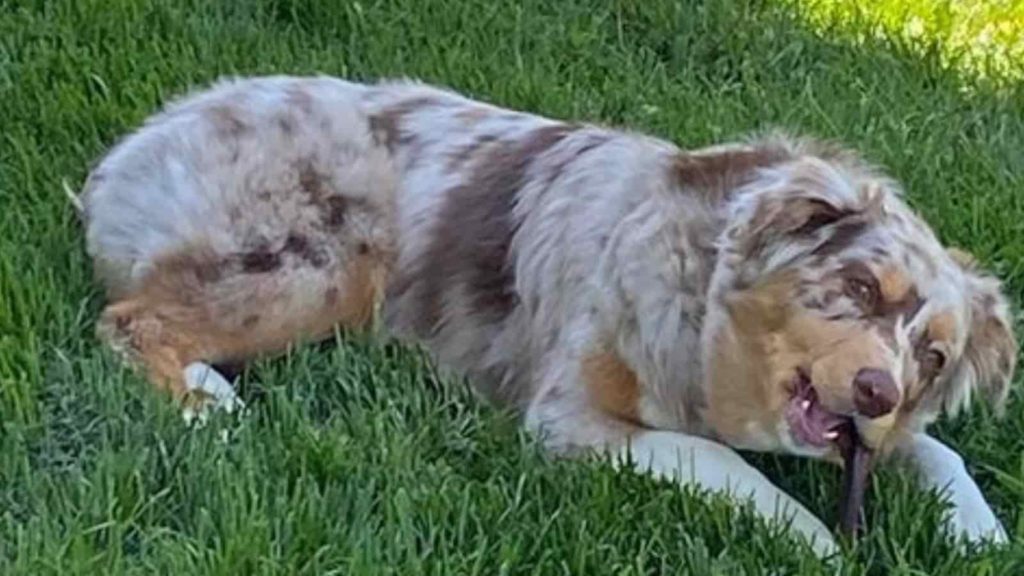Australian Shepherds are known for being loyal, energetic, and friendly additions to the family.
Since our dogs become so close to us, it can be very concerning when we notice that they are suddenly shaking, shivering, or trembling, especially when we are unsure of what to do.
Shaking, shivering, and trembling can occur in your Australian Shepherd, for several reasons, the most common being nervousness or muscle tremors. Shaking could have other causes being more troublesome and severe such as illness, seizures, or other medical conditions.
If you are unsure why your Australian Shepherd is shaking, shivering, or trembling, it’s best to consult a vet, but in the meantime, you can read about possible causes below.

Shaking versus seizures
It is important to realize the difference between whether your Australian Shepherd is shaking (having a muscle tremor) or experiencing a more serious problem like a seizure.
A lot of Australian Shepherd owners are concerned when they notice their Australian Shepherd beginning to shake suddenly. They automatically assume that their dog is experiencing a seizure; however, this is not always the case.
If your Australian Shepherd is having a seizure, they will not be aware of their surroundings and will lose mobility in their bodies. This is very different from shivers or tremors because your Australian Shepherd will still be aware of what is going on around them, as well as still being able to move their bodies.
Disclaimer: This post may contain affiliate links. We only recommend high-quality products that are used and recommended by real owners. If you use these links to buy something we earn a small commission.
Australian Shepherds are more prone to idiopathic seizures than other dog breeds. The causes are not well understood but are thought to be genetic.
Here are some other reasons why your Australian Shepherd may be having seizures:
- Liver disease
- Poor circulation
- Mineral deficiency
- Brain tumors
- Head injury
- Heartworm
- Kidney disease
- Anemia
- Stroke
If you think that your dog is having seizures and not common shakes, it is important to get them to a vet right away. (You can read more about seizures in dogs here.)

Why are my Australian Shepherd’s legs shaking?
The most common shaking in an Aussie is shaking or tremors that happen in their back legs or hind quarters.
These involuntary muscle tremors usually begin when the dog is a puppy. It can be caused by a condition called hypo-myelinogenesis. This means that the fatty tissue (myelin) that helps to protect and insulate the nerves has not developed properly.
If you notice an Aussie puppy being unusually clumsy, and or having tremors in its legs or head this could be the cause.
🐾 Note: The tremors usually get less or go away altogether as the puppy grows and the myelin (tissue around the nerves) develops more fully.
For dogs that continue to have tremors, the cause is very hard to determine and more research is needed to understand it fully. Because it is more common in Aussies it is thought to be linked to genetic and possibly an inherited condition.
Is My Aussies leg shaking serious?
Mild cases of hypo-myelinogenesis or leg shaking in Aussie puppies tend to clear up on their own as long as the puppy is getting proper nutrition and is healthy otherwise.
More serious cases are generally not life-threatening, but there is no cure. A dog can learn to live with the condition and live a happy healthy life otherwise.
Australian Shepherds with leg shaking should not be bred. Currently, there are no health screenings to check for this condition, but if you have a puppy or dog that has suffered from leg tremors it’s best to plan not to allow them to breed in order to avoid passing on this trait.

Why is my Aussie shaking?
Other reasons Australian Shepherds can shake may include they are cold, stressed, scared, or in pain.
You may notice along with shaking and shivering that your Australian Shepherd is lip-licking more than usual or yawning, this is oftentimes a sign that they are stressed.
🐾 Note: There are several other ways to tell if your Australian Shepherd is stressed such as being able to see the whites of their eyes, if they are whining, or if they are cowering/finding a place to go and hide.
Even though it is not fun to see our dogs shaking, it is oftentimes a normal reaction that occurs with Australian Shepherds; here are some other less concerning reasons your Australian Shepherd may be shaking and shivering:
- Excitement (normally stops once your pup has calmed down)
- Upset stomach (if this becomes a common occurrence, it is best to have your pup taken to the vet)
- Someone they aren’t familiar with is nearby (they will normally stop shaking soon after they are comfortable with the new person)
- Old age (a dog’s muscles begin to weaken as they age, shaking is a common side effect)
- Joint pain or arthritis (If this causes them severe pain or limping, a vet will normally provide them medication or other methods to provide them comfort)
- New haircut. If your dog has just been shaved of all its fur it may need a few days to a week to adjust to the temperature change
Some Australian Shepherd stomachs become upset because they have eaten something they shouldn’t; check out these articles for information about what your pup should and shouldn’t be eating:
Why Does My Australian Shepherd Eat Everything (Grass, Poop, Sticks, Dirt)?
Complete List of Fruit Australian Shepherd Can & Can’t Eat!
🐾 Tip: If your Australian Shepherd is shivering from the cold, it may indicate that he’s becoming hypothermic. Aussies’ double coats are meant to protect them from cold and hot temperatures. If your Aussie has been shaved this could also cause it to shiver.
If your Australian Shepherd is shaking and shivering because of anxiety, stress, or fear, there are several steps you can take to ensure that they stay calm and relaxed in stressful situations:
1. Reassure them — Removing your pup from the situation that is causing them stress can help them automatically calm down. Petting them and talking softly to provide them comfort can help ease their anxiety and cause their shaking to go away.
2. Keep yourself calm — To keep your dog calm, it is often important to keep yourself calm. Our dogs put so much trust into us, it is important to be there for them and show them how to stay calm. Keeping yourself calm will cause your pup to follow your lead!
3. Prepare for situations ahead of time — If you know that a situation will be occurring that makes your Australian Shepherd stressed, anxious, or fearful, try preparing for the situation early.

🐾 Tip: If your Australian Shepherd begins shaking when guests arrive at your house, it is probably because they are nervous to be around people, working on socializing them or putting them in a quiet space can help.
Some Australian Shepherds get very upset and anxious when they are separated from their owners, like when they go to the vet or groomer.
For some dogs going to the groomer can be very traumatizing. They may begin shaking if they know they are going to the vet/groomer, or even once they come home. It may be helpful to choose a groomer or vet that works well with your dog; this can eliminate any discomfort your pup may be feeling.
🐾 Note: Keep in mind that it is important not to comfort your Australian Shepherd too much if they are shaking or trembling from fear or stress/anxiety. Our dogs are smarter than we sometimes think! They may catch on that every time they begin to shake their owner runs to comfort them. This may result in your pup shaking on purpose to get attention.
While there are many non-concerning reasons your Australian Shepherd may be shaking, there are also more serious issues that could be making your pup react this way.
If your Australian Shepherd is shaking and shivering suddenly this may be a sign of conditions such as the following:
- Distemper (A contagious viral disease — prevented by vaccination)
- Hypoglycemia (blood sugar drops below certain limits)
- Shaker Syndrome (Inflammation of certain areas of the brain — not common in the Australian Shepherd breed)
A lot of serious medical conditions are accompanied by vomiting. If you notice your Australian Shepherd shaking along with vomiting, get them to the vet right away!
Pro Tip: If you are not able to get a hold of a vet near you, or you want to avoid an unnecessary ER trip, there are online resources that you can turn to. Here is our best recommendation:
Pawp: a 24/7 digital clinic for pets that connects you to an experienced vet
Why we love it:
🐾 Answers 24/7! 🐾 No waiting! 🐾 Get Answers Online with Local Vets! 🐾 Quick Response Time! 🐾 Easy Sign UP!
Try Pawp 7 Days For Free
Even though there are many physical and emotional reasons why your Australian Shepherd could be shaking, there is also the fact that their shaking can be inherited and is normally nothing to worry about as long as they are not experiencing severe shakes and tremors!
Why is my Australian Shepherd shaking and panting?
Shaking and panting can be a sign that your Australian Shepherd is too hot. Dogs don’t sweat like people and panting is one of the main ways to cool them down. They may also be over-excited. Older or overweight Australian Shepherds might pant and shake as a sign of weakness in the diaphragm.
What is Shaker Syndrome?
A serious condition that is not often found in the Australian Shepherd breed is “Shaker Syndrome,” also called “tremor syndrome” or “generalized tremor syndrome” (GTS). This is caused when the cerebellum (a part of the brain) becomes inflamed, causing the dog to shiver and shake.
Not only does shaker syndrome/tremor syndrome cause dogs to shake, but this syndrome also causes unwanted effects to other systems in their bodies.
Once the brain is inflamed, issues within the sensory system of the dog (vision, hearing, touch, taste, smell), and the muscles and motor movements (balance, coordination, posture, etc.) can become affected.
There is currently no known reason why our dogs suffer from this syndrome. It is a common idea that white breed dogs are more prone to this syndrome because of their melanin levels (pigment occurring in the hair, skin, and iris of the eye). It is also often stated that smaller dogs tend to have shaker syndrome (dogs under 33 lbs.) — often called “little white Shaker Syndrome”
These are interesting theories because other dogs have been known to have shaker syndrome that are not white breeds and above 33 lbs.

What are the signs and symptoms of Shaker Syndrome?
If you think your Australian Shepherd may be suffering from shaker syndrome, it is important to first look for other signs of illness or injury. If your dog is shaking without any other abnormal behavior, and this is not common for your dog, it is best to contact the vet as soon as possible!
Some symptoms and signs specifically linked to Shaker Syndrome include:
- Repetitive tremors/shaking (worsening after 1–3 days then remaining the same until treatment)
- Head bobbing/tilting
- Uncontrolled eye movements (rapid eye movement)
- Mild to severe shaking
- Inability to walk or exaggerated leg movements caused by shaking
- Shaking of the body limited to one area (head, legs, etc.)
- Shaking increases in severity as time goes on
- Loss of appetite
- Shaking is worse with change (after travel, or being in a new environment), called “intention tremors”
- Shaking goes away when the dog is sleeping
What is the treatment for Shaker Syndrome?
Shaker Syndrome is usually easily treatable by medication, specifically medicines that work very fast (corticosteroids). These medicines work to reduce inflammation in the brain which then eliminates the shaking and tremors.
The Australian Shepherd breed can handle a high dosage of medication and then slowly lower the dose as symptoms go away. Although, if the medicine is not used correctly or consistently, the symptoms of shaking and trembling may reappear.
Other medicines that are oftentimes used to cure shaker syndrome and tremors in the Australian Shepherd breed include muscle relaxers and anticonvulsants.
A veterinarian will first rule out any other common causes of shakes and tremors before diagnosing your pup with Shaker Syndrome. They will also do a blood and urine sample and a fluid sample from the lower part of the spine.
🐾 Tip: Make sure to give your vet all of the knowledge you have about your dog and its history previous to their shaking occurring, this can be important in determining whether or not they have shaker syndrome or not!
If your Australian Shepherd is shaking to a severe level or is very ill, your vet may decide to hospitalize them. There is no need to worry! Your vet will be able to do the necessary tasks to keep your pup happy and healthy.
After your Australian Shepherd is cured of shaking and any other illness, it is important to keep an eye on them and their actions to ensure that any symptoms do not reoccur, you may consider scheduling follow-up appointments with your vet!
Why does my Australian Shepherd shake its head?
Head shaking is a common symptom of shaker syndrome, especially since the brain is the place being affected the most. Although, shaker syndrome is typically generalized and occurs over the whole body.
If a vet has ruled out shaker syndrome, general shivers/tremors, and other extreme cases, your dog is likely having issues with its ear(s).
If your Australian Shepherd is shaking its head because of an ear issue it may be caused by common allergies, an ear infection, or an irritant within the ear such as ear mites, debris, or hair. Along with head shaking, your pup may scratch at its ears or rub its head against different surfaces to relieve any discomfort.
Typically, if your Australian Shepherd is shaking its head and the issue is not severe, a doctor can prescribe medications or creams such as ear drops that will fix the problem very quickly!
Here are some signs other than shaking that may indicate your pup has an ear infection:
- Redness inside the ear
- Yellow, brown, or bloody discharge
- Odor coming from the ear
- Swelling of the ear
- Crusts or scabs inside the ear
- Loss of balance
- Hearing loss
- Walking in circles
- Unusual eye movements
🐾 Tip: Since Shaker Syndrome has a lot of the same symptoms as ear infections, it is best to take your pup to the vet and get them checked out just to be sure!
While we strive to give the most accurate and helpful information about your pet’s health that we can, this article is meant to be informational only and not medical advice. Never disregard, avoid or delay in obtaining medical advice from your veterinarian or other qualified veterinary health care provider regardless of what you have read on this site or elsewhere.



